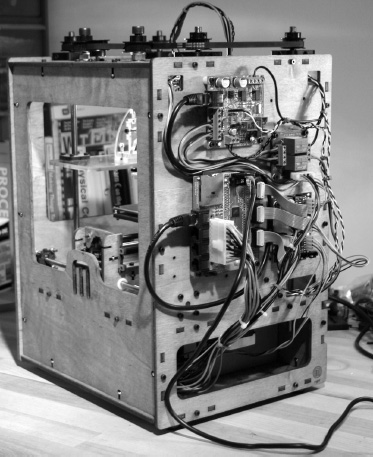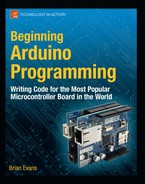The Arduino Ecosystem
The Arduino is not just one simple thing making it a little hard to define. It is a microcontroller platform, an open-source design that encourages modification and reuse, a community that has embraced and grown up around the Arduino, and a new crop of projects and devices that can trace their lineage to the Arduino and have in return contributed back to the development of various aspects of the entire Arduino ecosystem.
The Arduino Platform
The Arduino ecosystem begins with the Arduino platform, itself several layers of hardware and software working together to create a cohesive whole. We can start with the hardware interface board—that little, blue circuit board that you build into your projects. It has a fairly standard onboard microcontroller that can interact with the world around it by using its programmable inputs and outputs, as well as a USB port and controller for easily communicating with your computer. This USB connectivity and friendly sockets for hookup wires to easily plug in to, contribute to the high level of usability in the interface board design.
Equally important to this ecosystem is the Arduino development environment, a program based on the Processing development environment (http://processing.org) that you use to write, edit, compile, and upload your Arduino source code to the interface board. The Arduino team made the general assumption that people don’t really care about the myriad of technical specifics involved with microcontroller architecture—they just want it to do something cool. With that in mind, the Arduino development environment wraps up some of the more techie parts of programming AVR microcontrollers into a nice, simple library of Arduino-specific commands that are easier to use and easier to understand, and built right into every sketch written for the Arduino. This development environment is so versatile, that an Arduino interface board is not even needed to use it. Instead, we can use the very same AVR microcontroller as is built onto the interface board, but in an entirely different device—such as the example shown in Figure 1-3 of a microcontroller on a breadboard that has been programmed with an Arduino sketch.

Figure 1-3. Arduino compatible AVR microcontroller on breadboard
Finally, we are brought to the Arduino bootloader, a little chunk of code residing on the microcontroller that allows it to be easily programmed with a simple serial connection rather than cranky, external hardware. As long as the bootloader has been programmed onto the microcontroller beforehand, we can use that chip in whatever device we choose, such as the breadboard in Figure 1-3, and still write code for it using the rest of the Arduino platform. It helps if we use one of the microcontrollers common to the Arduino, but this is not always a prerequisite, with many other Atmel microcontrollers working nearly as well with little or no modification.
Open-Source Hardware
The Arduino platform is itself pretty useful for microcontroller projects, but that alone is not enough to propel the popularity and widespread adoption of the platform. Instead of closing the design of the interface board and development environment, the entire Arduino project is deeply entrenched in the emerging practice of open-source hardware. Unlike open-source software, of which Linux is usually the often-cited example, open-source hardware seeks collaboration where physical objects are the outcome. It engages a distributed model of hardware development with contributors generally residing in different parts of the world. Rather than closed systems, open source projects allow an individual freedom to access the source files of a design, make improvements, and redistribute these improvements to a larger community.
The Arduino ecosystem fundamentally embodies this aspiration for openness in design, architecture, collaboration, and philosophy. You can see it for yourself as all of the design files, schematics, and software are freely available to download, use, modify, remake, and even resell. What started as a seemingly serendipitous decision to open the Arduino design and software to the greater community, spurred by the closing of the design school where the Arduino team was first formed, has lead to an entirely new movement in design. The practice of contributors having the liberty to use these designs freely (free as in speech) and with no obligation to buy anything (free as in beer) helps make the Arduino as endearing as a collection of silicon and copper can be. Not to mention that this creative feedback loop ensures that every inspired innovation derived from the Arduino platform is met with ever more imaginative uses for even more new things.
Community
Maybe even more important than the hardware platform itself, the Arduino community is most likely the single greatest cog in the Arduino machine. This community of makers has contributed to the Arduino ecosystem by developing code and libraries, designing new hardware, teaching workshops and classes, and sharing what they’ve made. The Arduino is now being taught in high schools, colleges, and universities everywhere and “Arduino Night” is a regular ritual at any of a number of hacker spaces around the world. People coming together around the Arduino, as shown in the image of a soldering workshop at Maker Faire in Figure 1-4, contributes to this global community that has made the Arduino such a success.

Figure 1-4. Soldering Workshop, Maker Faire, San Mateo, CA, 2011, courtesy SparkFun Electronics
Community engagement for a project like the Arduino is essential for the success or failure of the project. Fortuitous timing also helped in that the Arduino came to the scene at the same time that the return of the Maker and DIY movements also began again. This ever-increasing new crop of makers means that you never have to look hard to find willing co-conspirators to help on anything open source; whether it’s through pockets of helpful individuals in the interweb or your neighborhood hacker space, help is never that far away.
Arduinoland
This community-driven research and development seems to have a magical effect on any project to come out of the wake of the Arduino, and this proverbial kingdom of mystical wonder is something I’m going to call Arduinoland. Maybe it’s because the hardware design works, is open, and is hackable, or maybe it’s because of a communal desire to build upon each other’s work, but whatever it is, in Arduinoland, soldering iron marvels, difficult to nearly impossible to pull off in a garage just ten years ago, seem to happen every day. Anything from interactive electronic textiles, autonomous flying aircraft, networked beer keg refrigerators, photographic missions to near space, and immersive architectural installations have all sprouted from this open Arduino ecosystem.
Take the MakerBot CupCake CNC for example, a sub-$1,000, kit-based, plastic-extruding, 3D printer shown in Figure 1-5. Needing an electronics system to interpret codes sent from an attached computer to drive the positioning of the printhead and the temperature of the extruder, the MakerBot team built off the Arduino hardware platform and the development environment to create an open platform for building plastic objects.

Figure 1-5. MakerBot CupCake 3D printer with Arduino-compatible electronics
Or for all of those brown thumbs out there that can never seem to water their house plants when it’s most needed, a team of New York University students developed a tweeting plant moisture meter called Botanicalls, shown in Figure 1-6. Based on the Arduino reference design, combined with an off-the-shelf Ethernet module and a simple moisture probe all wrapped up in a leafy-green circuit board, the Botanicalls device will post a tweet and blink an LED whenever the soil moisture of the plant falls below a certain threshold, letting its owner know that they should get out their watering can.

Figure 1-6. Botanicalls Arduino-based tweeting plant water meter, courtesy Botanicalls
These projects and many others have all benefited from the rapid development and reliable longevity brought to you by Arduinoland and the hard work put in by the Arduino team and community at large to create an open architecture that enables continued and accelerated growth and creativity.
